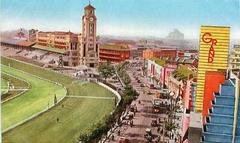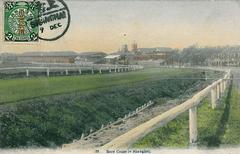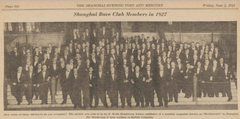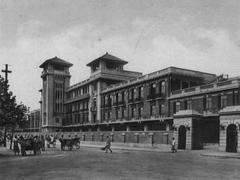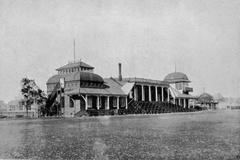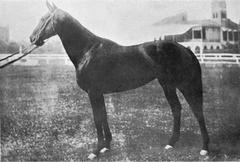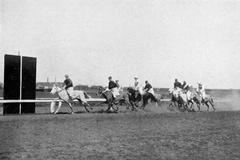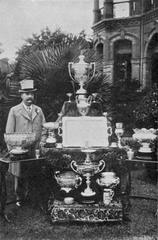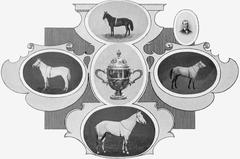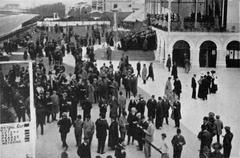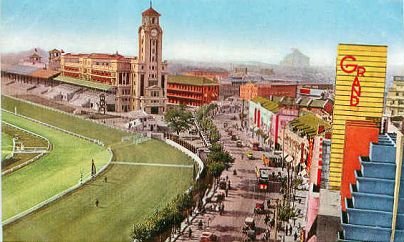
Shanghai Race Club: Visiting Hours, Tickets, and Historical Significance in Shanghai
Date: 14/06/2025
Introduction
The Shanghai Race Club is a landmark that encapsulates the dramatic transformation of Shanghai from a colonial treaty port to a dynamic global metropolis. Centrally located at what is now People’s Square, the former racecourse and its grandstand are powerful reminders of the city’s layered history—melding colonial opulence, social stratification, and urban innovation. Today, while horse racing has long ceased, the legacy of the Shanghai Race Club endures through its distinctive architecture and its pivotal role in the city’s urban and cultural landscape. This detailed guide explores the club’s fascinating history, architectural features, social significance, and provides practical information for visiting the site, including hours, tickets, and nearby attractions.
Embark on a journey through time and space to discover how the Shanghai Race Club remains a cornerstone of Shanghai’s heritage and a testament to the city’s enduring spirit of transformation (eastchinatrip.com, The China Project, Spatial History).
Table of Contents
- Introduction
- Historical Overview: Origins and Evolution
- Architectural and Urban Significance
- Social and Cultural Impact
- Transformation and Legacy
- Visiting Today: Hours, Tickets, and Practical Information
- Guided Tours and Nearby Attractions
- FAQ
- Conclusion and Travel Tips
- References
Historical Overview: Origins and Evolution
Founding and Early Years
The Shanghai Race Club was established originally in 1850, with its first races held on a temporary track that would later become the heart of the International Settlement. By 1862, the club was formally organized, and a permanent racecourse was built where People’s Square now stands. The club quickly became the focal point for Shanghai’s foreign elite, reflecting both their recreational pursuits and their dominance in the city’s social hierarchy (eastchinatrip.com).
Colonial Zenith
Through the late 19th and early 20th centuries, the Shanghai Race Club flourished as the city’s most prestigious social institution. The grandstand—completed in 1933 with Art Deco flourishes—became an iconic architectural feature, hosting not only races but also balls, dinners, and charity galas. The club’s prominence was such that major race days attracted crowds of up to 20,000, making it a central node in Shanghai’s cosmopolitan life (The China Project).
Decline and Transformation
The outbreak of the Second Sino-Japanese War and subsequent political upheavals led to the club’s decline. After the Communist takeover in 1949, the grounds were repurposed for public use, becoming People’s Square and People’s Park. The grandstand survived and has since housed various cultural institutions, including the Shanghai Art Museum and, currently, the Shanghai History Museum (eastchinatrip.com).
Architectural and Urban Significance
Architectural Features
The main grandstand and clubhouse were designed in a blend of neoclassical and Art Deco styles, symbolizing Shanghai’s status as a cosmopolitan metropolis. Key features include:
- Symmetrical facades with imposing columns
- A distinctive clock tower
- Large arched windows and terraces for panoramic views
- Expansive, column-free interiors enabled by reinforced concrete (The China Project)
Urban Impact
The club’s central location influenced the city’s spatial layout, with major roads like Nanjing Road radiating from the racecourse perimeter. The transformation of the grounds into People’s Square ensured that the site remained a civic and cultural center—now hosting the Shanghai Museum, Urban Planning Exhibition Center, and other major attractions (China Discovery).
Social and Cultural Impact
Social Stratification and Cosmopolitanism
Initially exclusive to foreign expatriates, the club gradually welcomed elite Chinese members. Race days became occasions for diverse social interaction, with thousands attending and mingling across class and ethnic lines (Spatial History). However, privilege and segregation were also visible, with the best seats and club facilities reserved for the wealthy and powerful.
Public Engagement
The club’s raffle tickets and betting halls popularized gambling in Shanghai, attracting citywide participation. Despite controversy—especially in later years as a “gambling den”—the club contributed to a culture of modern leisure and entertainment (Culture Shock Shanghai).
Adaptive Reuse and Memory
After its closure, the grandstand’s adaptive reuse as cultural institutions reflects Shanghai’s approach to heritage preservation—integrating colonial-era structures into new civic functions while honoring their historical significance (China Discovery).
Transformation and Legacy
The Shanghai Race Club’s transformation from elite racecourse to vibrant public square mirrors Shanghai’s broader evolution. The site’s adaptive reuse, commitment to public space, and preservation of architectural heritage demonstrate the city’s ongoing negotiation between tradition and progress. Today, the grandstand’s clock tower remains a striking visual reminder of the city’s cosmopolitan past, while People’s Square thrives as a central gathering place for all.
Visiting Today: Hours, Tickets, and Practical Information
Location and Getting There
- Address: North end of People’s Square, Huangpu District, Shanghai
- Metro: People’s Square Station (Lines 1, 2, 8)
- Bus: Multiple routes serve the area
Site Access
- People’s Square and Park: Open 24 hours daily, free admission
- Shanghai History Museum (Grandstand Building):
- Open Tuesday to Sunday, 9:00 AM–5:00 PM (last entry 4:30 PM)
- Closed Mondays and some public holidays
- Entry is generally free; certain exhibitions may have a small fee
Accessibility
- The area is wheelchair accessible, with ramps, elevators, and public restrooms available.
- Nearby cafés, restaurants, and shopping centers provide additional amenities.
Guided Tours and Nearby Attractions
Guided Tours
Several operators offer walking tours that cover the history and architecture of the former Shanghai Race Club and People’s Square. Check platforms like GetYourGuide or local agencies for details.
Nearby Attractions
- Shanghai Museum: Renowned for its Chinese art collections (4-minute walk)
- Shanghai Urban Planning Exhibition Center: Interactive exhibits on the city’s development (7-minute walk)
- Shanghai Grand Theatre: World-class performances (10-minute walk)
- Nanjing Road: Bustling shopping street (15-minute walk)
- Yu Garden and City God Temple: Both about 23 minutes on foot, offering insights into Shanghai’s traditional culture
FAQ
Q: What are the Shanghai Race Club visiting hours?
A: People’s Square is open 24/7. The Shanghai History Museum is open Tuesday to Sunday, 9:00 AM–5:00 PM (last entry 4:30 PM), and closed Mondays.
Q: Is there an entrance fee?
A: People’s Square is free; the Shanghai History Museum is generally free, with some exhibitions charging a small fee.
Q: Can I enter the Shanghai Race Club building?
A: The exterior can be viewed at any time. Interior access is available during museum hours or special events.
Q: Are guided tours available?
A: Yes; tours are offered by local agencies and typically include historical highlights of the club and adjacent attractions.
Q: Is the area wheelchair accessible?
A: Yes; both the square and museum are accessible for visitors with mobility needs.
Conclusion and Travel Tips
The Shanghai Race Club’s legacy is central to understanding Shanghai’s past and present. From its grand Art Deco architecture to its transformation into People’s Square, the site offers a unique window into the city’s social fabric, urban planning, and architectural innovation.
Travel Tips:
- Best times to visit: Early mornings or weekdays to avoid crowds; spring and autumn for pleasant weather.
- Photography: Capture the grandstand’s clock tower and the oval layout of People’s Park from elevated viewpoints.
- Combine with other sites: Plan to visit the Shanghai Museum or stroll down Nanjing Road for a full day’s experience.
- Stay informed: Check official museum websites for current exhibitions and special events.
Download the Audiala app for curated tours, up-to-date information, and exclusive content on Shanghai’s historical sites. Follow us on social media for insider tips and inspiration for your next visit.
References
- Shanghai Race Club Visiting Guide: History, Highlights & Visitor Information at People’s Square, 2025, East China Trip (eastchinatrip.com)
- Shanghai Race Club: History, Architecture, and Visiting Guide to Shanghai’s Iconic Historical Site, 2025, The China Project (The China Project)
- Shanghai Race Club Visiting Hours, Tickets, and Its Historical Significance in Shanghai, 2025, Spatial History (Spatial History)
- Shanghai Race Club Visiting Hours, Tickets & Historical Guide to This Iconic Shanghai Landmark, 2025, China Discovery (China Discovery)
- Shanghai Race Club Historical Overview, 2025, Culture Shock Shanghai (Culture Shock Shanghai)
